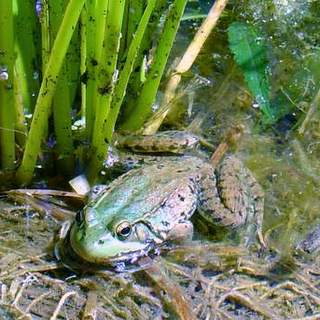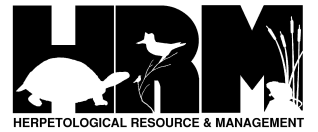Green Frog
Overview:
Scientific Name: Rana clamitans melanota
Size: 2.4 – 4.2” (adult length)
Status: One of the most abundant frogs throughout the Great Lakes region.

Habitat:
Will inhabit ponds, lakes, swamps, sloughs, impoundments, and slow streams. More tolerant of open, sparsely vegetated areas than other frogs (notably Bullfrogs). Usually avoid shallow and temporary bodies of water.
Adult Coloration:
May be green, yellowish green, olive, brown, or any combination. Occasionally a blue Green Frog will be found. Upper lip is green or yellow. Often with dark spotting on back and sides and dark bars on hind legs. Belly white, sometimes with gray mottling.
Adult Characteristics:
Dorsolateral fold (raised ridge of skin) extends from eye down one-half to two-thirds of the back. Mature males have a bright yellow throat and a very large tympanum (circular ear structure). In females the tympanum will be smaller or the same size as the eye, and the throat is white, light yellow, or cream, often with dark mottling. Voice: One or a series of short, descending, metallic notes, similar to plucking strings on a banjo. Sometimes a low growl is emitted during territorial aggressive behavior. e.g., http://www.youtube.com/watch?v=xtLU4thIwm and http://www.youtube.com/watch?v=ryGMRGWbJeo
Larvae Characteristics:
Tadpoles are plump with long tails and an olive to brownish green back with dark flecks over back and upper and lower tail fins. White or cream iridescent belly often has gray mottling, and intestines are not visible through the skin.
Species Confused With:
Bullfrog tadpoles are very similar to those of the Green Frog, but dark spots on the tail fin are usually restricted to the upper lobe. Adult Bullfrogs are also similar to adult Green Frogs, but they can be larger and lack dorsolateral folds on the back. Mink Frogs have similar dark marking on the back but lack dorsolateral folds; though in areas where range overlap occurs, Green Frogs may not have dorsolateral folds due to mimicry of Mink Frogs. Therefore, distinction between the two should also be made by the musky odor of the Mink Frog and the different markings on the hindlegs: Green Frogs with dark crossbands and Mink Frogs with rounded spots or lengthwise stripes.
References:
- Amphibians and Reptiles of the Great Lakes Region by Jim Harding
- Harding, J.H. and J.A. Holman. 1992. Michigan Frogs, Toads, and Salamanders. MSU Cooperative Extension Service and MSU Museum. Extension Bull. E-2350, 144 pp.
- Ruthven, A. G., H. B. T. Gaige, et al. 1912. The herpetology of Michigan, by Alexander B. Ruthven. Crystal Thompson and Helen Thompson; Memoranda towards a bibliography of the archaeology of Michigan, by Harlan I. Smith; prepared under the direction of Alexander G. Ruthven. Lansing, Mich., Wynkoop Hallenbeck Crawford, State Printers.
- Holman, J. A. 2012. The Amphibians and Reptiles of Michigan: A Quaternary and Recent Faunal Adventure. Detroit, Mich., Wayne State University Press.
- Conant, R., and Collins, J. T. 1998. Reptiles and Amphibians: Eastern, Central North America. Houghton Mifflin Harcourt Press.
